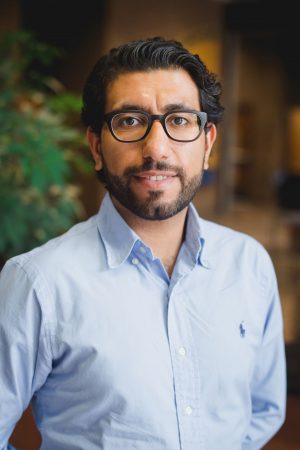
Hassan Masoud, assistant professor of Mechanical Engineering-Engineering Mechanics at Michigan Technological University, has won a $520,255 National Science Foundation CAREER Award, “Collective Hydrodynamics of Robotic Swimmers and Surfers at High Reynolds Numbers.”
Dr. Masoud will use his award to examine the hydrodynamics of aquatic robots locomoting in orderly ensembles and identify the collective behaviors that emerge from their flow-mediated interactions.
Dr. Masoud earned his Ph.D. in Mechanical Engineering from the Georgia Institute of Technology and conducted postdoctoral research under the joint supervision of Howard Stone in the Department of Mechanical and Aerospace Engineering at Princeton University and Michael Shelley at the Courant Institute of Mathematical Sciences at NYU. He joined the Department of Mechanical Engineering-Engineering Mechanics at Michigan Tech as an assistant professor in 2017.
CAREER awards, administered under the Faculty Early Career Development Program, are the NSF’s most prestigious form of support and recognition for junior faculty who “exemplify the role of teacher-scholars through outstanding research, excellent education and the integration of education and research within the context of the mission of their organizations.”
We congratulate Assistant Professor Hassan Masoud on his outstanding accomplishment!
Abstract: Robotic swarms have attracted much attention in recent years due to their vast potential applications. In particular, there has been a growing interest in aquatic robots, either swimming underwater or surfing at the air-water interface. By using large numbers of individuals working in tandem through local communication, a swarm of underwater swimmers or interfacial surfers can augment their collective intelligence while maintaining relatively simplistic designs. Harnessing this unique, joint ability leads to achieving superior functionalities, which makes aquatic robots very appealing for a myriad of practical applications, including surveillance, monitoring of invasive species, tracking weather and sea conditions, pollution management, etc. This project aims to obtain an in-depth understanding of many-body hydrodynamic interactions in the collective motion of robotic swimmers and surfers at high Reynolds numbers. The design of robots chosen for the studies is motivated by species in nature that have mastered their respective terrains. The swimmers mimic the general form of a fish, with the tail flapping providing the thrust, while the surfers take inspiration from water-walking insects. The investigations will be conducted using a synergistic application of high-fidelity numerical simulations and laboratory experiments. Validated simulations allow for exploring an extensive range of flow regimes and combinations of relative positions between the robots. Coupled with reinforcement learning algorithms, they also enable searching for optimal strategies for collective locomotion. The unsteady flows generated by the motion of robots in the experiments will be captured via time-resolved, volumetric particle tracking velocimetry. The fundamental knowledge gained during this project is expected to directly contribute to the design and implementation of future aquatic robots capable of functioning alongside each other with a high degree of coordination, similar to the behaviors exhibited by fish in schools and birds in flocks. The planned research studies in this project are coupled with a range of educational activities that involve outreach to middle and high school students, engagement with the general public, mentorship of community college and graduate students, and curriculum development.
Read more
What Tiny Surfing Robots Teach Us About Surface Tension
